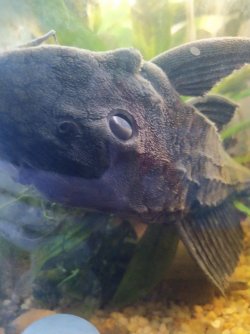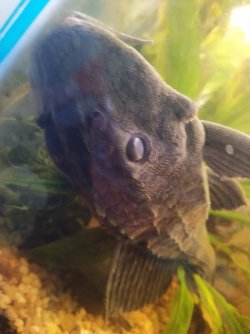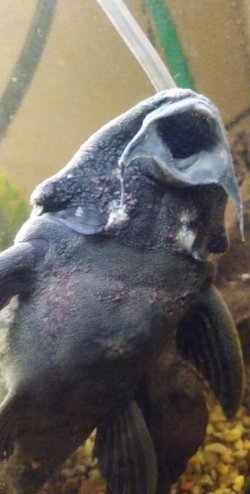Hello all, I've had this rhino pleco ever since he was a baby (starting out when I had a stupid 1 gallon aquarium back in 2012-3), and slowly over the years upgraded his tank as i figured out what was going on (the stupid fish store owners/workers I talked to said that he was an algae eater and I wanted a companion for my betta back then that would help clean up the glass and keep him company, me being in my teens didn't know that I should have asked for specifics, especially how big he would be and what tank size is suitable after they pointed him out to us) from a 1 gallon tank that I started with him and a betta, then a 10 gallon tank after he started to grow and realized he would fit on the floor of the 1 gallon, to finally this 30 gallon tank that I bought after doing some research a couple years back as to how big he actually gets (that is the maximum tank size I can fit in this space at the moment and haven't been able to upgrade or rehome him since he's grown to the size he's at which has basically stayed at around 10 inches, which is I guess roughly how big he should be even though a time period which I assume I accidentally stunted his growth. He's been happy over the years in this 30 gallon as though he does make a huge mess basically all the time (and it was honestly a pain cleaning up after him, cleaning out the filter with all the material that gunked it up after he rummaged through the tank), I used a filter rated for a 60 gallon tank that he probably aught to reside in.
Fast forward 5 years after i got the 30 gallon tank to now, and after a few days a month ago where he would try jumping out of the tank from what I assume to be bad water conditions (this is the first time I had seen him do it in his life and after a huge water change over several days and treating the tank with salt), he seemed to have gotten better and content (afterwards I saw that there was actually an injury he seemed to sustain on his soft belly that may have irritated him so much that he tried jumping, though he may have obtained that injury in the process of trying to jump out (always kept a lid on but he would wake me up at night for days on end with him banging his lip/head against the lid). He stopped jumping for a while with consistent water changes until two days ago.
Two days ago, a few days after I did my last water change, he started trying to jump out of the tank again this time I was a lot more worried though as it didn't make any sense: he didn't seem to have any injuries, the tank water was essentially pristine (7.2 pH, 0 - 0.25 ppm Amm, 0 ppm Nitrites, 5-10 ppm Nitrates) and the temperature had been consistent (I was actually worried with the huge heat that it would impact my tank so I specifically climate controlled the room with AC for the last few weeks unlike normal to around 78 F)...I had no idea what was going on. Upon further inspection I saw that he had these reddish blisters all over his body at this point, on his fins, on his belly, on his head...his fins and really anywhere his bones would protrude started to turn white as if the skin was wearing off, his dorsal fin was frayed, his scales (not sure if he actually has them but the plates that cover his body?) were turned different colors and almost peeling off...his eyes became sunken in his head...he has trouble orienting himself and sometimes just flat out lies on his back
this time I was a lot more worried though as it didn't make any sense: he didn't seem to have any injuries, the tank water was essentially pristine (7.2 pH, 0 - 0.25 ppm Amm, 0 ppm Nitrites, 5-10 ppm Nitrates) and the temperature had been consistent (I was actually worried with the huge heat that it would impact my tank so I specifically climate controlled the room with AC for the last few weeks unlike normal to around 78 F)...I had no idea what was going on. Upon further inspection I saw that he had these reddish blisters all over his body at this point, on his fins, on his belly, on his head...his fins and really anywhere his bones would protrude started to turn white as if the skin was wearing off, his dorsal fin was frayed, his scales (not sure if he actually has them but the plates that cover his body?) were turned different colors and almost peeling off...his eyes became sunken in his head...he has trouble orienting himself and sometimes just flat out lies on his back  ...I guess my question is, is there anything I can really do at this point? I looked up the life expectancy of this particular pleco and the few sparse sources I could find all seemed to agree on around 10 years, I'm just wondering is it really worth trying to medicate the tank now? I'm not sure anymore. I checked the water and besides the ammonia which either comes out higher from the tap with ammonia or the ammonia test kit just seems to never give a 0 reading, it looks to be good
...I guess my question is, is there anything I can really do at this point? I looked up the life expectancy of this particular pleco and the few sparse sources I could find all seemed to agree on around 10 years, I'm just wondering is it really worth trying to medicate the tank now? I'm not sure anymore. I checked the water and besides the ammonia which either comes out higher from the tap with ammonia or the ammonia test kit just seems to never give a 0 reading, it looks to be good  Any help would be appreciated and thank you all in advanced for reading this, I realize it's a bit of a life story type of thing but I almost felt like this frustration over the last few years was bubbling up to this point.
Any help would be appreciated and thank you all in advanced for reading this, I realize it's a bit of a life story type of thing but I almost felt like this frustration over the last few years was bubbling up to this point.
Fast forward 5 years after i got the 30 gallon tank to now, and after a few days a month ago where he would try jumping out of the tank from what I assume to be bad water conditions (this is the first time I had seen him do it in his life and after a huge water change over several days and treating the tank with salt), he seemed to have gotten better and content (afterwards I saw that there was actually an injury he seemed to sustain on his soft belly that may have irritated him so much that he tried jumping, though he may have obtained that injury in the process of trying to jump out (always kept a lid on but he would wake me up at night for days on end with him banging his lip/head against the lid). He stopped jumping for a while with consistent water changes until two days ago.
Two days ago, a few days after I did my last water change, he started trying to jump out of the tank again
 this time I was a lot more worried though as it didn't make any sense: he didn't seem to have any injuries, the tank water was essentially pristine (7.2 pH, 0 - 0.25 ppm Amm, 0 ppm Nitrites, 5-10 ppm Nitrates) and the temperature had been consistent (I was actually worried with the huge heat that it would impact my tank so I specifically climate controlled the room with AC for the last few weeks unlike normal to around 78 F)...I had no idea what was going on. Upon further inspection I saw that he had these reddish blisters all over his body at this point, on his fins, on his belly, on his head...his fins and really anywhere his bones would protrude started to turn white as if the skin was wearing off, his dorsal fin was frayed, his scales (not sure if he actually has them but the plates that cover his body?) were turned different colors and almost peeling off...his eyes became sunken in his head...he has trouble orienting himself and sometimes just flat out lies on his back
this time I was a lot more worried though as it didn't make any sense: he didn't seem to have any injuries, the tank water was essentially pristine (7.2 pH, 0 - 0.25 ppm Amm, 0 ppm Nitrites, 5-10 ppm Nitrates) and the temperature had been consistent (I was actually worried with the huge heat that it would impact my tank so I specifically climate controlled the room with AC for the last few weeks unlike normal to around 78 F)...I had no idea what was going on. Upon further inspection I saw that he had these reddish blisters all over his body at this point, on his fins, on his belly, on his head...his fins and really anywhere his bones would protrude started to turn white as if the skin was wearing off, his dorsal fin was frayed, his scales (not sure if he actually has them but the plates that cover his body?) were turned different colors and almost peeling off...his eyes became sunken in his head...he has trouble orienting himself and sometimes just flat out lies on his back  Any help would be appreciated and thank you all in advanced for reading this, I realize it's a bit of a life story type of thing but I almost felt like this frustration over the last few years was bubbling up to this point.
Any help would be appreciated and thank you all in advanced for reading this, I realize it's a bit of a life story type of thing but I almost felt like this frustration over the last few years was bubbling up to this point.Attachments
-
 239028780_385349172953548_5919535677325376039_n.jpg81.2 KB · Views: 159
239028780_385349172953548_5919535677325376039_n.jpg81.2 KB · Views: 159 -
 240440742_574110400460525_3907727428262583433_n.jpg68.2 KB · Views: 116
240440742_574110400460525_3907727428262583433_n.jpg68.2 KB · Views: 116 -
 236224369_1202101320301285_7467235010572967043_n.jpg67.9 KB · Views: 115
236224369_1202101320301285_7467235010572967043_n.jpg67.9 KB · Views: 115 -
 240389047_431185418258780_3619814089629422286_n.jpg40.4 KB · Views: 118
240389047_431185418258780_3619814089629422286_n.jpg40.4 KB · Views: 118 -
 240442313_368795704738629_3672671465692803473_n.jpg38 KB · Views: 119
240442313_368795704738629_3672671465692803473_n.jpg38 KB · Views: 119

